Guest Post by Dr. Robert Malone
Walking, keeping strong and fit will most likely lead to a longer life.
The old cliche that aging is not for sissies may hold true for some, but these days we are lucky to have so much solid science and technology available to keep us on the right track to a longer healthy life. But it us up to each of us to decide on whether to act on this knowledge.
The truth is that one of the best indicators of quality of life is whether or not you are becoming fragile in your advancing years. For those of us of a certain age, it is important to work to not just improve cardio health, but also to maintain and build flexibility and muscle strength. Keeping active, walking, even sports are all linked to longer longevity.
One of the most powerful and useful tests for predicting length of remaining lifespan is almost too simple. In a study published in 2014, a research group in Brazil came up with a simple cost-free test that measures physical fragility and accurately predicts all-cause mortality over a 14 year period. This peer reviewed paper, published in the European Journal of Preventative Cardiology, is titled “Ability to Sit and Rise From the Floor as a Predictor of All-cause Mortality”.
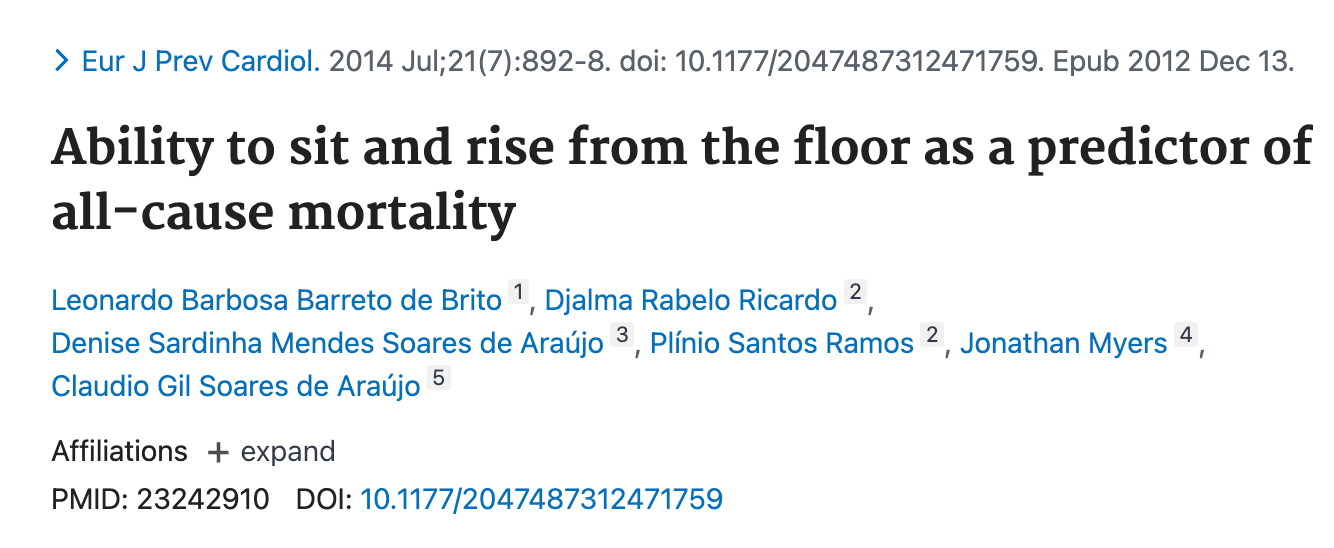
The test looks like this:
Please try this test for yourself and report back if you wish in the comments section.
Abstract (from the paper):
Background: While cardiorespiratory fitness is strongly related to survival, there are limited data regarding musculoskeletal fitness indicators. Our aim was to evaluate the association between the ability to sit and rise from the floor and all-cause mortality.
Methods: 2002 adults aged 51-80 years (68% men) performed a sitting-rising test (SRT) to and from the floor, which was scored from 0 to 5, with one point being subtracted from 5 for each support used (hand/knee). Final SRT score, varying from 0 to 10, was obtained by adding sitting and rising scores and stratified in four categories for analysis: 0-3; 3.5-5.5, 6-7.5, and 8-10.
Results: Median follow up was 6.3 years and there were 159 deaths (7.9%). Lower SRT scores were associated with higher mortality (p < 0.001). A continuous trend for longer survival was reflected by multivariate-adjusted (age, sex, body mass index) – (p < 0.001) from lower to higher SRT scores. Each unit increase in SRT score conferred a 21% improvement in survival.
Conclusions: Musculoskeletal fitness, as assessed by SRT, was a significant predictor of mortality in 51-80-year-old subjects. Application of a simple and safe assessment tool such as SRT, which is influenced by muscular strength and flexibility, in general health examinations could add relevant information regarding functional capabilities and outcomes in non-hospitalized adults.
The major results are below (in one simple figure from the paper)
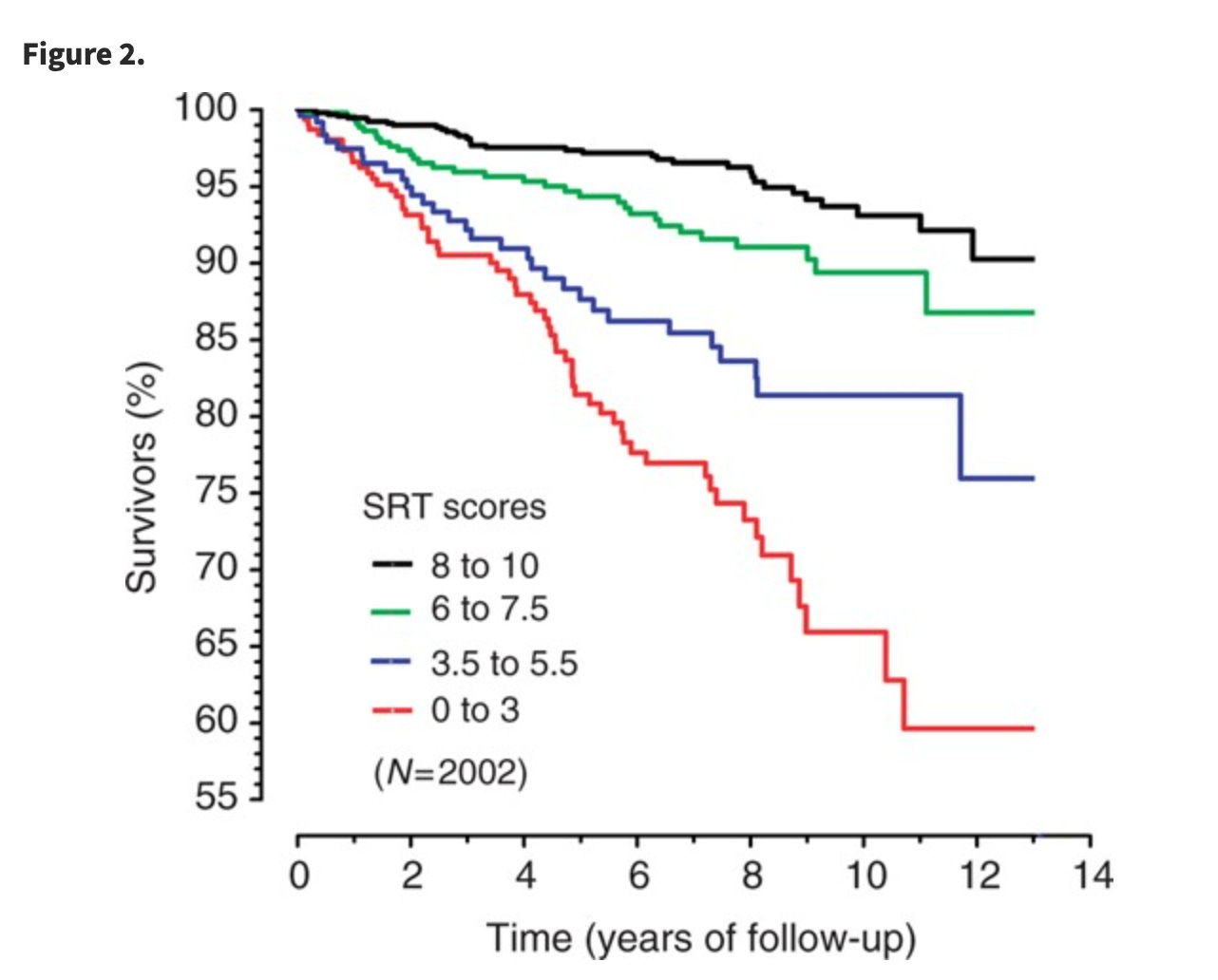
Of course, in this study age was a big factor in determining who could and couldn’t perform the test well. So, take a gander at the full study here to decide for yourself where you fit into the matrix of the results.
Bottom line – if you didn’t score well, it might be time to get on the floor and practice some yoga or pilates! Building muscle core strength can also be accomplished through swimming, walking and even gardening. Every bit helps!
Another very interesting study shows that simply walking daily is associated with a longer lifespan.
The paper was published in a JAMA journal and is titled “Association of Daily Step Patterns With Mortality in US Adults”.
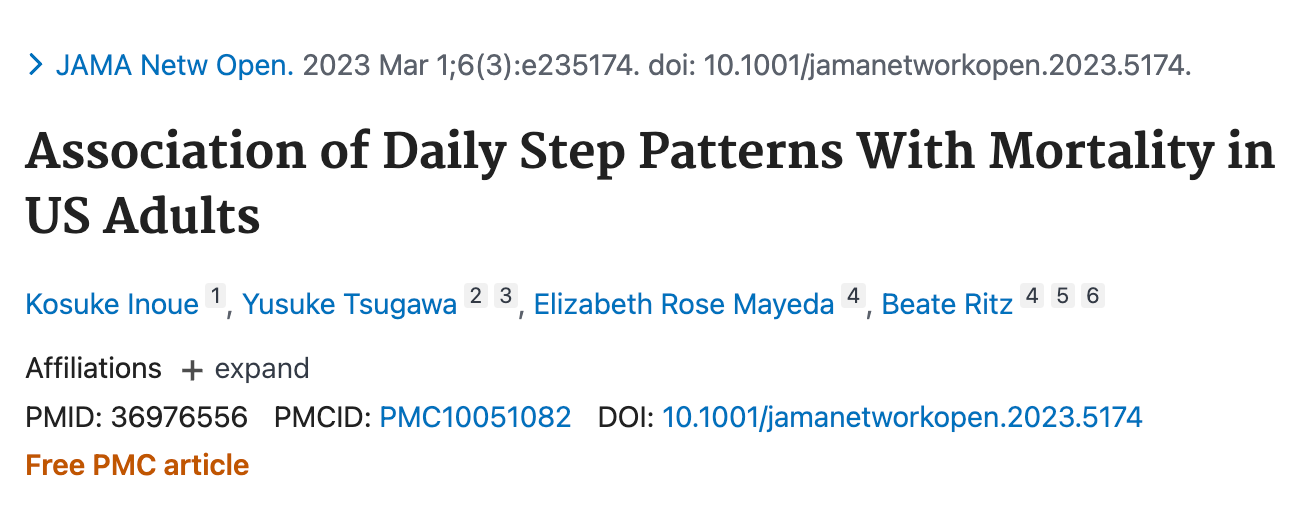
Conclusions and relevance: In this cohort study of US adults, the number of days per week taking 8000 steps or more was associated with a lower risk of all-cause and cardiovascular mortality in a curvilinear fashion. These findings suggest that individuals may receive substantial health benefits by walking just a couple days a week.
The figure below (taken from the paper) shows the association between walking and all cause mortality over a ten year follow-up period for various subgroups:
“Subgroup Analyses for the Association Between the Number of Days Taking 8000 Steps or More Throughout the Week and 10-Year All-Cause Mortality Risk by Age and Sex”.
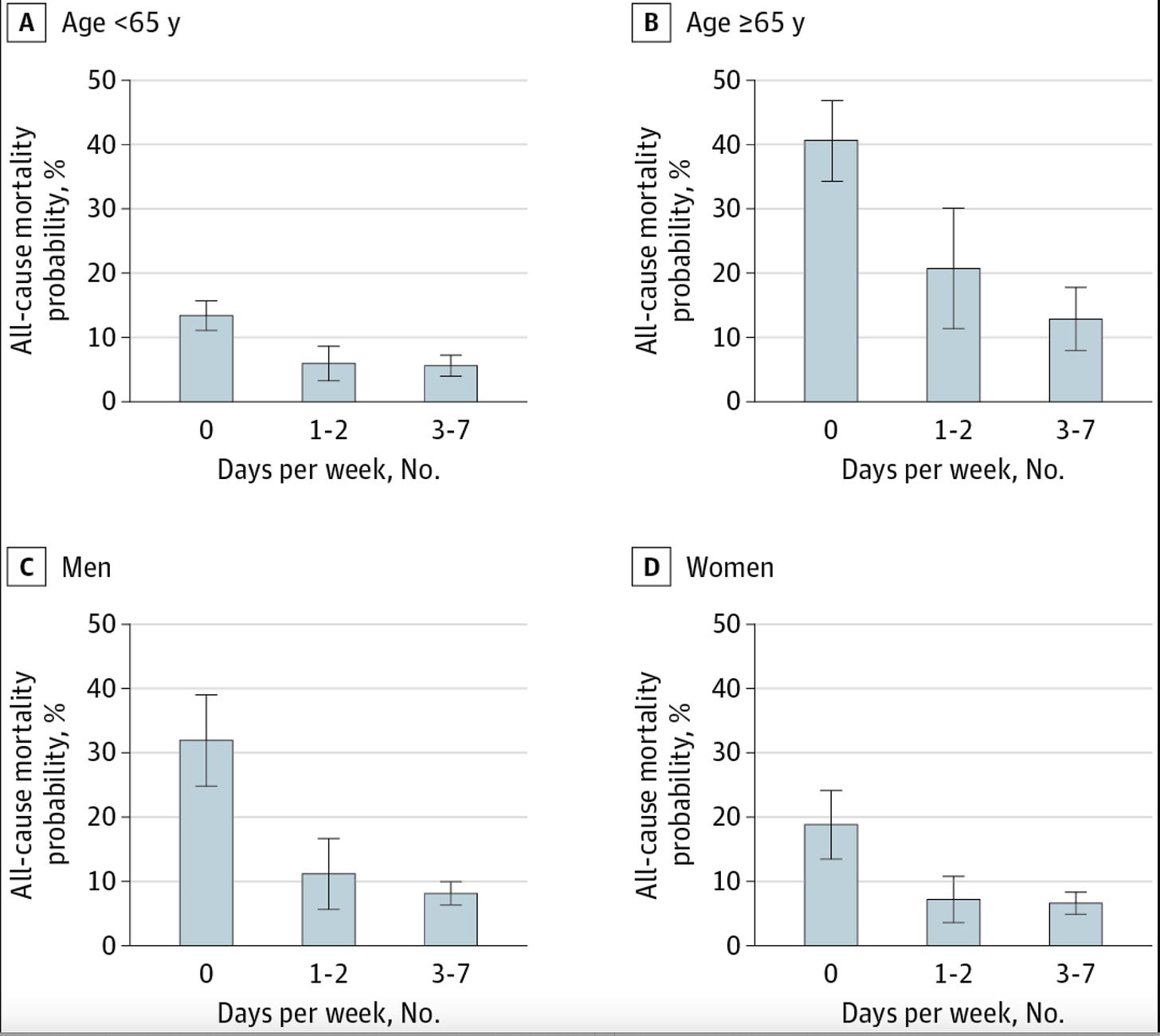
The model adjusted for age; sex; race and ethnicity; insurance status; marital status; smoking; body mass index; estimated glomerular filtration rate; statin use; history of diabetes, hypertension, cardiovascular disease, cancer, and emphysema; and average daily step counts.
The results of this study are pretty clear cut. That is that walking for just a couple of days a week with 8000 steps of more will increase the probability that you will live longer. This is particularly true for those who are older than 65 years. The benefits of walking appear to be greater for men than women, although both groups benefited greatly.
Another, earlier study titled, “Association of Daily Step Count and Step Intensity With Mortality Among US Adults” measured steps in an older population. This study was published in JAMA in 2020 and demonstrated similar results:
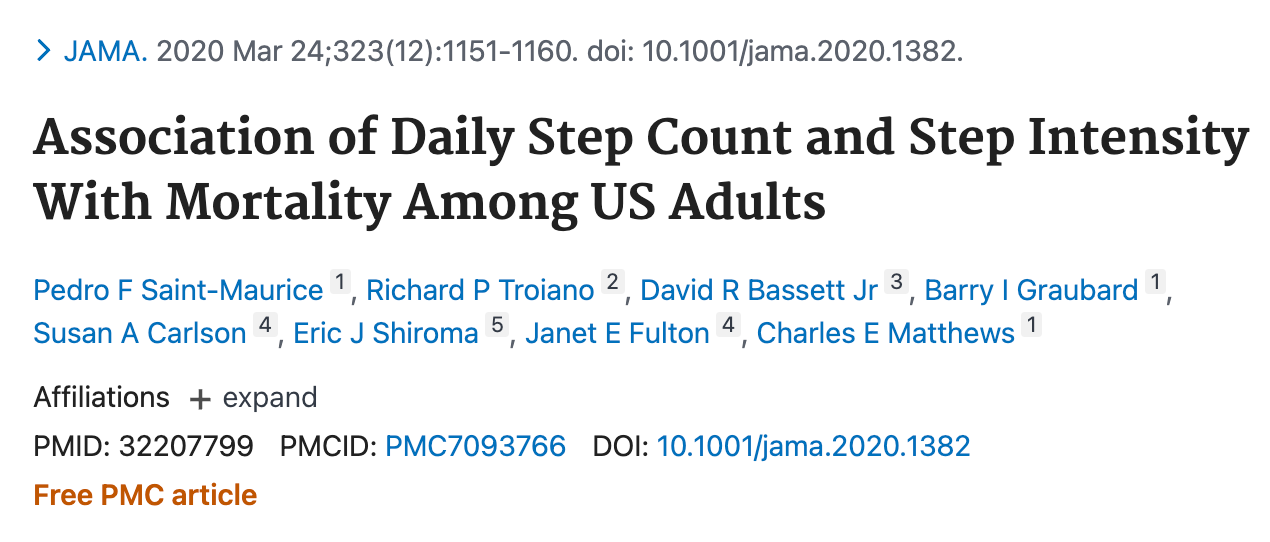
The Abstract is as follows:
Objective: Describe the dose-response relationship between step count and intensity and mortality.
Design, setting, and participants: Representative sample of US adults aged at least 40 years… wore an accelerometer for up to 7 days (from 2003-2006). Mortality was ascertained through December 2015.
Exposures: Accelerometer-measured number of steps per day and 3 step intensity measures (extended bout cadence, peak 30-minute cadence, and peak 1-minute cadence [steps/min]). Accelerometer data were based on measurements obtained during a 7-day period at baseline.
Main outcomes and measures: The primary outcome was all-cause mortality. Secondary outcomes were cardiovascular disease (CVD) and cancer mortality. Hazard ratios (HRs), mortality rates, and 95% CIs were estimated using cubic splines and quartile classifications adjusting for age; sex; race/ethnicity; education; diet; smoking status; body mass index; self-reported health; mobility limitations; and diagnoses of diabetes, stroke, heart disease, heart failure, cancer, chronic bronchitis, and emphysema.
Results: A total of 4840 participants (mean age, 56.8 years; 2435 [54%] women; 1732 [36%] individuals with obesity) wore accelerometers for a mean of 5.7 days for a mean of 14.4 hours per day. The mean number of steps per day was 9124. There were 1165 deaths over a mean 10.1 years of follow-up, including 406 CVD and 283 cancer deaths. The unadjusted incidence density for all-cause mortality was 76.7 per 1000 person-years (419 deaths) for the 655 individuals who took less than 4000 steps per day; 21.4 per 1000 person-years (488 deaths) for the 1727 individuals who took 4000 to 7999 steps per day; 6.9 per 1000 person-years (176 deaths) for the 1539 individuals who took 8000 to 11 999 steps per day; and 4.8 per 1000 person-years (82 deaths) for the 919 individuals who took at least 12 000 steps per day.
Compared with taking 4000 steps per day, taking 8000 steps per day was associated with significantly lower all-cause mortality …
Conclusions and relevance: Based on a representative sample of US adults, a greater number of daily steps was significantly associated with lower all-cause mortality. There was no significant association between step intensity and mortality after adjusting for total steps per day.
For older adults, walking about 8000 steps a day is associated with significantly lower all-cause mortality.
This is pretty simple folks, walking is a great way to both enjoy being outside and a great way to increase your life.
Quality of life AND a longer life, what could be better?
It is the lifestyle fixes for issues such as obesity, cardiac disease, high blood sugar, some types of inflammatory disease and other chronic conditions that may have the most impact on our health. We don’t need health care professionals to tell us this.
The established fact that lifestyle changes can “cure” so many ills is something physicians don’t stress enough. The truth is that many people can benefit from counseling and support on how to make simple lifestyle changes that will impact both quality of life and their chances of living longer. These types of lifestyle changes can reduce dependencies on costly prescription pharmaceuticals for chronic conditions while also reducing the need for interventional care as you age. For most of us, simple lifestyle changes can impact both quality of life and extend lifespan.
Some ideas:
- Developing simple goals and strategies such as being accountable to yourself by doing daily weigh-ins, keeping track of your steps through fitness wrist bands and cell phone apps is a good way for many to build routine.
- Enrolling and following through with a fitness class tailored to your needs can make a huge difference. That may include yoga, yoga for seniors, pilates and even a general fitness class. Make it fun.
- Find a walking partner.
- Take the stairs, walk or ride a bike to the shops, and just – walk. Commit to taking the dog, the kids, your partner -whoever to walk with you.
- Those who have knee issues should consider other low impact activities – such as swimming, floor exercises – including yoga or chair yoga. Other good activities may include gardening, housecleaning or stationary biking. Just commit to doing whatever you can do on a daily basis to keep your body flexible and moving.
- If you can’t find a local fitness partner, consider finding an internet group to join. Both for support and for accountability.
Taking control of one’s health is empowering. It can start with little changes or with a complete make-over.
It does takes hard work and a commitment to health, which in the end, is a commitment to ourselves.
It is my sincere desire to provide readers of this site with the best unbiased information available, and a forum where it can be discussed openly, as our Founders intended. But it is not easy nor inexpensive to do so, especially when those who wish to prevent us from making the truth known, attack us without mercy on all fronts on a daily basis. So each time you visit the site, I would ask that you consider the value that you receive and have received from The Burning Platform and the community of which you are a vital part. I can't do it all alone, and I need your help and support to keep it alive. Please consider contributing an amount commensurate to the value that you receive from this site and community, or even by becoming a sustaining supporter through periodic contributions. [Burning Platform LLC - PO Box 1520 Kulpsville, PA 19443] or Paypal
-----------------------------------------------------
To donate via Stripe, click here.
-----------------------------------------------------
Use promo code ILMF2, and save up to 66% on all MyPillow purchases. (The Burning Platform benefits when you use this promo code.)












Photos of dogs that have been abused by democrat owners …….. sad indeed.
That’s how democrats view their constituents.
Looking at you Lizzie Fletcher and Sheila JACKSON Lee.
If you are unwilling to exercise your dog, get a small dog that can get all the exercise it needs running around the house. No matter the size and activity level, keep the food at specified levels and the treats and table scraps to a minimum. Overfeeding is just as bad as lack of exercise, both will kill your dog early.
At the very least walk your Dogs once a day, so they get some.recreation and some together time with the Master.
Both benefit greatly, and you will have a well behaved Dog because he has something to look forward to.
Two Communists downvoted you so far.
Walked 4-5 mi. Saturday. Sweetie wanted to do a historic house tour. Made 7 of the 8, all built between 1790-1905. Those 7 are actual residences; one is for sale at $1.9MM. Artwork, rugs & furnishings were straight out of “Garden & Gun”.
I feel for those dawgs. Ours get plenty of exercise. Yes, democrat owners, most likely. And I’ll try that exercise when Tito’s is absent from my system.
Two hour hike in the woods and creek everyday for my dog and myself regardless of weather. In below zero we cut that to 45-60 minutes. My dog is my retirement health program. Hunting breeds are the best for this followed by herding breeds. Mine is a Brittany Spaniel, if you don’t exercise them they will become a pain in the house.
4 hours walking a golf course and carrying my clubs keeps the heart pumping for 5 months a year. In winter I have a treadmill and free weights for lite workouts. I used to ski but the old body no longer likes the cold.
Those poor little(fat) doggies. In the animal world, they’re probably “hot as fuck” though.
I’d like to see the owners in leashes and collars…followed by whips.
You’re probably on the wrong site for that.
After stopping surfing after 25 years of it I started packing on some pounds. I’m 6’1″ and solid as a brick shithouse but damn I gotta start moving more. A 60# bag of play sand in my old ALICE pack is the plan , start at a mile or so.
People who do that to their pets are psychotic.
They are not sane.
The last dog I had was a spaniel lab mix. Very smart and because she got a lot of exercise and we restricted her diet to healthy foods, she lived to 17.
I’ve seen a few articles about this lately, but no conclusive evidence that there is more benefit to walking outside vs on a treadmill. Say, at a treadmill desk while working. I expect being outside, especially in a forest or near plants, is better. Outside there are twists, turns and elevation changes whereas a treadmill is one straight long line. What about adding some ruck weight?